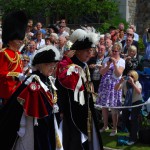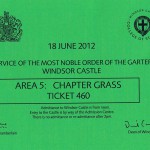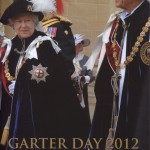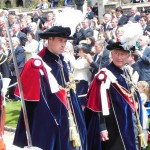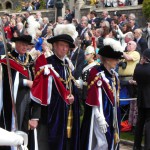The Most Noble Order of the Garter
Early this summer I had the privilege to be invited to the Service of the Most Noble Order of the Garter, which was held at Saint George’s Chapel at Windsor Castle on June 18 of 2012, in the year of Diamond Jubilee of the reign of Her Majesty Queen of the United Kingdom Elizabeth II. To me, just like to all the subjects of the United Kingdom to become part of the service of the Most Noble Order of the Garter was the most important event of this year.
We arrived at Windsor Castle early and were surprised by a big queue, which started to form the day before. The queue seemed to be so huge, and it took us almost 10 minutes to walk to the “tail” of it.
As it turned out, many people took their place in the queue late in the previous evening and spent the whole night at the walls of the castle so that when the castle opens they would be in the first lines at the walkway, upon which the Queen, much adored by everyone and her husband Prince Philip, Duke of Edinburgh would pass by, as well as members of the Royal Family and other Knights of the Order of the Garter. People in the line were well “equipped,” according to the British weather – that is, they were holding umbrellas, in case it would rain, and wore hats, in case the sun would be too hot. Almost everyone had folding chairs, some little supply of victuals and water.
At approximately 12 o’clock, the castle was opened and the queue set into motion. Ten or fifteen minutes passed by, and after being checked for security reasons we entered Windsor Castle. At the entrance we were handed a colourfully decorated leaflet, in which there was detailed description of the coming ceremony of the service of the Most Noble Order of the Garter. We were assigned a place on the lawn, close to the entrance to St. George’s Chapel. It was the most fortunate place to watch everything that was going to happen.
It is no secret to anybody, that all the events, in which the Queen and members of the Royal Family participate, are very popular in society, because they allow people the chance to see the Queen and sometimes talk to her, and to share in the centuries-old traditions and rituals of the British monarchy. Besides that, any event in which the Royal Members would participate turn into colourful and unforgettable shows demonstrating flawless British etiquette, and displaying ladies’ hats and attires. These events allow people to get acquainted with the highest class of society, as well as with other celebrities of the British Commonwealth.
After we accommodated ourselves on the lawn, the show began. Closer to the beginning of the service, Her Majesty Queen’s subjects started to arrive to St. George’s Chapel. As a rule, they were distinguished people of the United Kingdom, among whom there were many aristocrats. All of them were clad in beautiful and solemn arrays. The most crucial element of ladies’ attires were hats, matched in colour with their costumes or dresses, as well as purses and brooches; while for the men it was – tail-coat costumes, cylinder hat and a cane. All of it was so cute. All the arriving guests greeted us and one another with their smiles and friendly looks. Definitely, such events unite the society and make people closer to each other. The first ones, whom we recognized among the arriving ones, were parents of Kate Middleton, Duchess of Cambridge. The Middletons, having greeted us all, proceeded to the chapel. Following Kate Middleton’s parents other celebrities arrived; among them were scientists and military ranks, politicians and businessmen. Some of them we recognized ourselves, about others we had to ask our neighbours on the lawn.
As soon as everybody gathered together and the church bells stroke half past two in the afternoon, the ceremony of the service of the Order of the Garter began. Everything began with the procession of the Royal Guard, army officers, heralds, musicians, clergy representatives, who were followed by members of the Most Noble Order of the Garter in medieval costumes. People gaily and enthusiastically applauded the members of the Order passing by, among whom there were Her Majesty Queen of Great Britain Elizabeth II; her husband, Prince Philip, Duke of Edinburgh; also there were Their Royal Highnesses Prince Charles of Wales; William, Duke of Cambridge; Anna, Princess the Royal; Andrew, Duke of York; Earl Edward of Essex; Duke Richard of Gloucester; Duke Edward of Kent, Princess Alexandra, the Honourable Lady Ogilvy, and also Sir Anthony Acland, Baron Robin Butler, Sir John Major and other members of the Order. The procession was closed by the Royal Guards – the Beefeaters.
The whole procession headed for St. George’s Chapel, which from the day of its foundation has been the headquarters of the Order of the Garter and the venue for the annual Garter services. The entire service was broadcast through loudspeakers and started with the National Anthem “God Save the Queen.” Everyone around us stood up and picked up the words of the hymn. You could see in people’s countenances the awe, thrill and love that filled them when they sang the anthem. Everyone was pleading with the Lord to preserve the Queen. After the Anthem, there were a prayer and a sermon, then, spiritual hymns were sung.
The history of the origin of the Most Noble Order of the Garter goes deep into the Middle Age, back to the years of the reign of King Edward III.
In 1350, English King Edward III was returning home after glorious victories he won at the cities of Calais and of Crècy, where the French were defeated. In order to praise his victorious army, the King desired to establish a Knights Order. One of the main objectives of creating the Order was to add more luster to that endless war, which the king had already been waging against the King of France for a long time. Edward III needed the war hardships to be perceived as wonderful adventures, which noble and brave knights have to aspire to, to win the victory over the adversary, who unjustly took from their sovereign his lawful legacy.
According to the chronicles, when the English king was founding the Order, he obviously had in mind the pattern of the Knights of the Round Table. In historic chronicles there is a lot of confusion concerning this subject, consequently, the moment of founding the new Order and holding a big tournament of the Round Table at Windsor Castle were “blended” into one story. Chronicler Jean de Belle informs, that the king out of his noble heart decided to rebuild Windsor Castle, which had been once built by Arthur, where the Round Table was originally set, to honour his valiant knights, who were at his side at the time and who served him so well.
The king exceedingly appreciated their service and counted them so noble that, according to his words, no one like them could be found in any other kingdom. And it seemed to him that no matter what honours he would do them, they could not be excessive – so much he loved them (those knights). And our king announced in the whole kingdom that a great feast would be held and big reception on the occasion of founding this Round Table, and he invited noble ladies and maids, knights and armor-bearers from everywhere to arrive for this great feast…
At Windsor Castle an outhouse was erected for the knights to gather in, but the name for the Knights Union had not been found yet. And here upon the historic scene a beautiful lady appeared, for whom historic chronicles give different names – “Queen Philippa;” Countess of Kent and Countess of Salisbury. But, most probably, this beautiful lady was Countess of Salisbury, a brave beauty, who several years before the described events with a few knights and servants lived in the Wark Castle in the North of England. Her husband was languishing in French captivity and, seizing the opportunity, Scottish king David put the castle under a siege. The castle’s defenders led by the countess fought back all the storming attempts and so the Scots started preparing for a long-term siege. It seemed that the castle and its defenders were doomed, but then the English army led by young Edward III came to their rescue.
Countess of Salisbury lost a blue embroidered garter from her full dress at a ball in Windsor. The garter fell on the stone floor and the king, having stopped at it, was looking at the cute ribbon studded with precious stones. But many courtiers attributed hidden meaning to the king’s look, for his infatuation with the beautiful countess was no secret to anyone. The dancers stopped and from all sides hushed chuckles were heard. The king understood the reason behind his court’s laughter, but he stooped over, lifted up the garter himself and fixed it onto his sleeve. Then he spoke the words, which later became the Order’s motto, “Shamed be the person who thinks evil of it!”
Some scholars question the authenticity of the story with the countess of Salisbury, but there is no other explanation in the modern science for so seemingly strange motto and insignia of the Order. Although there were some other assumptions made, for example, this ribbon could have belonged to the king himself and he used it to give a sign to start a battle, tying this garter to the tip of his spear. But then who would and why would anyone think evil of it? Soon after the ball, at Saint George’s Cathedral – and George is the patron of warriors, king Edward III gathered the most prominent warriors of the British Kingdom – his 24 faithful knights, who distinguished themselves at the battle of Crècy. Some of them belonged to the highest English nobility, others, although not having sonorous titles, were brave and courageous. So, in the middle of the XIVth century in England the secular Order of the Garter was founded. Later it was thought to be almost a direct descendant of King Arthur’s Round Table. The Order of the Garter became the highest British award, which all courtiers aspired to get, but it was bestowed only for very distinguished services.
The Order of the Garter had some characteristics, which later became necessary for such unions: limited number of members, knights’ loyalty to only one order – to enter some other order was just unthinkable. Exceptions were made only for friendly heads of other states or their attendants on rare occasions, but it was not always approved. So, for example, French King Louis XI accused the Duke of Burgundy Charles the Bold of treason when he agreed to become an honoured member of the Order of the Garter. The British Order of the Garter became an intermediary step between an order as a sign of belonging to a certain circle of people and order as an award. The emblems of secular orders, which were founded later, were of different shapes, to emphasize their distinction from spiritual orders, and they were rarely cross-shaped. The Charter of the Order of the Garter contains the description of necessary vestments and insignia, determined the colour of costumes and their linings as well as the inscription on the garter; also, certain events were specified, for which it was necessary to wear the full-dress costume. The Order’s insignia was a gold-embroidered garter, but then other signs were introduced – for common occasions: a figure of Saint George on horseback, plaited hair, images of a deer, swan, hunter’s horn, et cetera.
The Silver Star of the Order of the Garter, of diamond cutting, has an octagonal elongated shape. In its center there is an equilateral four-pointed cross, covered with red enameling, and around the cross, the order’s ribbon is depicted with the order’s motto. On the reverse side of the star there are eight golden gibs, which allow free motion of its ends and eight loopholes to fasten the star to the costume.
Russian king Peter I during his visit declined the honour to become the knight of the British Order since at that time he had already been thinking of founding a national Russian Order. Russian emperors Alexander I, Nicholas I and Alexander II were Knights of the Order of the Garter.
The Order of the Garter still exists in England to this day: all the noblemen of Great Britain honour the privilege to become the knights of this Order, but the number of its members never exceeds 24 people. On the day of the feast the Knights of the Order of the Garter wear medieval costumes, which include white tights, and they tie under their left knee (ladies – above their elbows) a blue silk ribbon with a golden buckle upon which the Order’s motto is embroidered: «HONI SOIT QUI MAL Y PENSE».
At the present moment, the members of the Most Noble Order of the Garter are:
- Her Majesty Queen of Great Britain Elizabeth II;
- His Royal Highness Prince Philip, Duke of Edinburgh;
- His Royal Highness Prince of Wales Charles;
- His Royal Highness Prince Andrew, Duke of York;
- His Royal Highness Prince Edward, Earl of Essex;
- Her Royal Highness Princess Royal;
- His Royal Highness Prince, Duke of Kent;
- Her Royal Highness Princess Alexandra, the Honourable Lady Ogilvy;
- His Royal Highness Prince Richard, Duke of Gloucester;
- His Royal Highness Prince William, Duke of Cambridge;
- His Majesty Reigning Emperor of Japan Akihito;
- Sir Antony Acland;
- Her Majesty Queen of Netherlands Beatrix;
- Former Great Duke of Luxemburg Jean;
- Sir Peter Inge;
- His Majesty King of Sweden Carl XVI Gustaf;
- Baroness Margaret Thatcher;
- Lord Edwin Bramall;
- Her Majesty Queen of Denmark Margrethe II;
- His Majesty King of Norway Harald V;
- His Majesty King of Spain Juan Carlos I;
- Baroness Soames (daughter of Winston Churchill).

